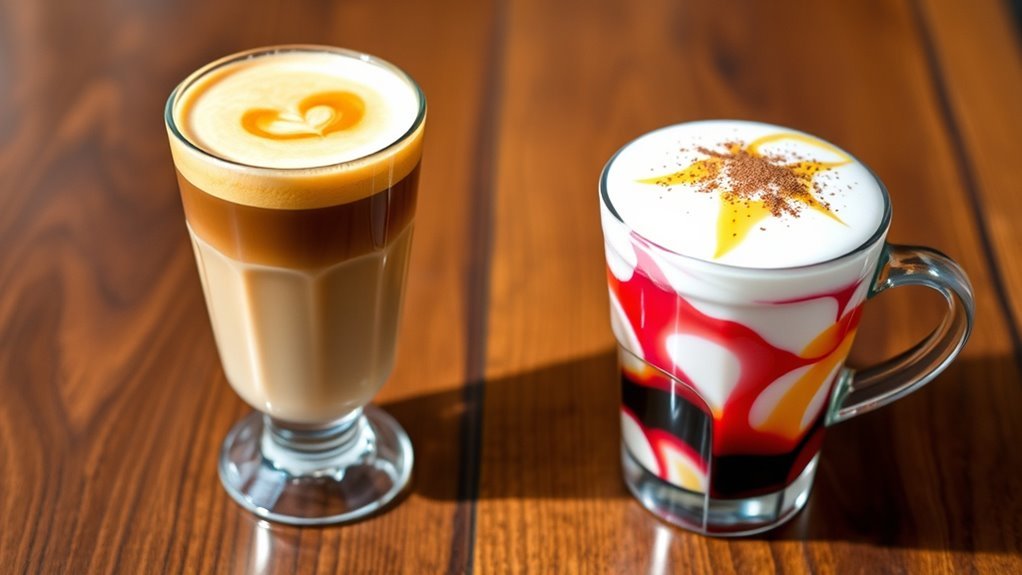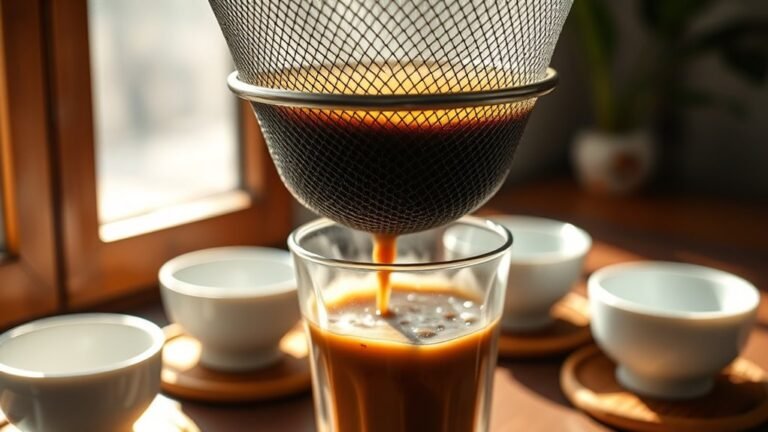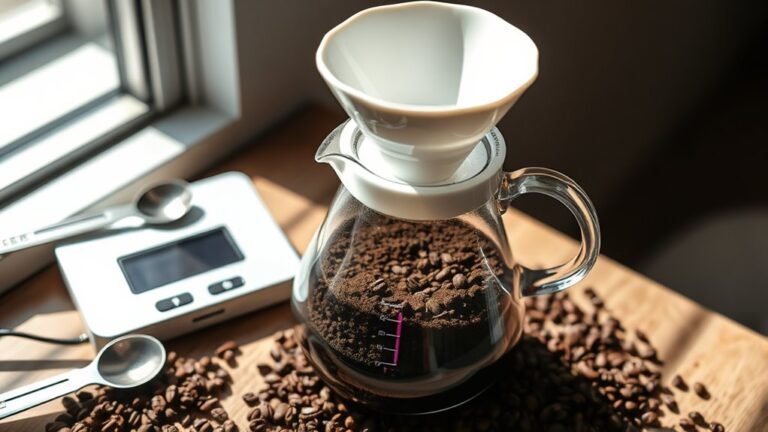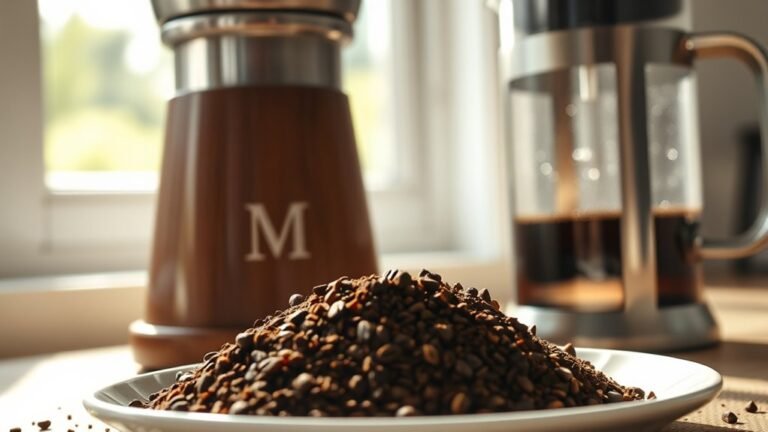How to Make a Macchiato: Traditional vs. Modern
To make a traditional macchiato, pull a rich espresso shot and gently top it with a dollop of velvety milk foam, keeping it simple and bold. For a modern twist, steam milk with added flavors like vanilla or caramel and pour it over espresso, often served in a larger cup with creative layers. Both styles value espresso’s intensity but differ in sweetness and presentation. Explore these methods further to master the art and nuances of each approach.
History of the Macchiato

The macchiato, which means “stained” or “spotted” in Italian, dates back to the early 20th century and was created to distinguish a simple espresso from one with just a touch of milk. Its Italian origins reflect a cultural significance tied to the pursuit of balance and authenticity in coffee. As coffee evolved, the macchiato emerged as a symbol of subtlety—allowing you to enjoy espresso’s boldness while softening it slightly. Across Italy, regional variations developed, adapting the macchiato to local tastes without losing its essence. Understanding this history connects you to a tradition that values freedom in flavor and expression, encouraging you to appreciate coffee not just as a drink but as a cultural experience shaped by time and place.
Key Ingredients for a Traditional Macchiato
To craft a traditional macchiato, you’ll need high-quality espresso with a rich crema that forms the base of the drink. Choosing the right milk—typically whole milk for its balance of creaminess and texture—is essential for achieving the perfect froth. Mastering basic frothing techniques guarantees your milk creates a delicate, airy foam to “mark” the espresso just right.
Espresso Quality Essentials
Although you might focus on milk textures or presentation, the heart of a traditional macchiato lies in the quality of its espresso. To truly capture that essence, you need to pay attention to a few critical factors. First, espresso bean selection is paramount; choose freshly roasted, high-quality beans with a balanced flavor profile to guarantee richness and clarity. Second, perfect extraction timing is crucial—aim for approximately 25-30 seconds to avoid bitterness or sourness, ensuring a smooth and intense shot. Finally, grind consistency plays a crucial role, as uniform grounds allow even water flow and ideal flavor extraction. Master these essentials, and your macchiato will embody the freedom of bold, authentic espresso, setting the perfect foundation for the subtle milk mark that defines the drink.
Milk Type Selection
Once you’ve mastered pulling a perfect espresso shot, your focus shifts to selecting the right milk that complements without overpowering. Traditional macchiatos rely on whole milk for its creamy texture and balanced sweetness, but milk alternatives offer freedom for dietary preferences while requiring careful consideration of frothing techniques.
| Milk Type | Characteristics |
|---|---|
| Whole Milk | Rich, creamy, froths well |
| Skim Milk | Lighter, less creamy, froths with more air |
| Almond Milk | Nutty flavor, challenges in frothing |
| Oat Milk | Sweet, creamy, mimics dairy frothing |
| Soy Milk | Creamy, slightly beany, froths moderately |
Choosing your milk wisely guarantees your macchiato remains true to its traditional roots or embraces modern variation seamlessly.
Frothing Techniques Basics
Mastering frothing techniques is crucial for creating the perfect macchiato, as the texture and temperature of the milk directly influence the drink’s balance and flavor profile. When you froth milk, your goal is to achieve a silky microfoam that complements the espresso without overpowering it. Focus on these fundamentals:
- Angle and depth: Position the steam wand just below the milk surface to introduce air gradually, creating fine bubbles for smooth milk texture.
- Temperature control: Heat milk between 140°F and 150°F to preserve sweetness and avoid scalding.
- Consistent motion: Keep the pitcher steady, swirling the milk to integrate foam uniformly.
These frothing techniques guarantee your macchiato delivers a harmonious blend of creamy texture and robust espresso flavor.
Equipment Needed for Making Macchiatos
Before you start crafting the perfect macchiato, you’ll need some essential equipment that guarantees both quality and consistency. A reliable espresso machine is your foundation, extracting rich, concentrated shots with precision. Pair it with a high-quality coffee grinder to confirm freshly ground beans, releasing full flavor potential. For that signature creamy touch, a milk frother is indispensable—it lets you create the ideal microfoam, whether you prefer traditional steamed milk or a modern twist. Finally, don’t overlook serving cups designed to hold small, concentrated drinks; their size and shape enhance the macchiato experience, preserving aroma and temperature. Having these tools at your disposal empowers you to explore macchiato variations confidently, offering freedom to craft each cup exactly how you like it.
Step-by-Step Guide to Making a Traditional Macchiato
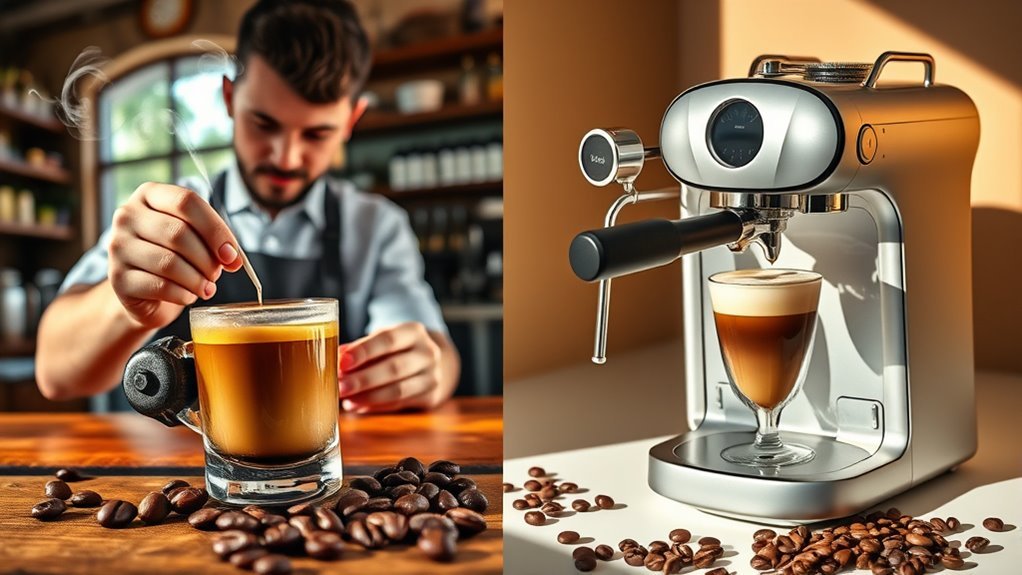
You’ll start by pulling a perfect shot of espresso, ensuring a rich and balanced base. Next, carefully spoon a small amount of velvety milk foam directly on top to create the signature “stain” of a traditional macchiato. Finally, serve it in a small cup to highlight its strong, concentrated flavors.
Espresso Preparation Basics
Espresso serves as the foundation for a traditional macchiato, and getting it right is crucial to achieving the perfect balance of boldness and subtlety. You’ll want to start by dialing in the espresso grind—too coarse, and your shot will be weak; too fine, and it’ll be bitter. Next, focus on the extraction time; aim for about 25-30 seconds to pull a rich, balanced shot. Here’s what to keep in mind:
- Use freshly ground beans with a consistent espresso grind size
- Tamp evenly to guarantee uniform water flow
- Monitor extraction time closely to avoid under or over-extraction
Mastering these basics frees you to craft a macchiato that’s as bold or delicate as you like, setting the stage for the signature milk foam to come.
Adding the Milk Foam
One key element that distinguishes a traditional macchiato is the delicate layer of milk foam that crowns the espresso shot. To add this, start by steaming your milk to create the right milk foam type—microfoam, which is smooth and velvety. Aim for a foam consistency that’s light yet stable enough to rest atop the espresso without sinking. Use a steam wand to aerate the milk gently, introducing just enough air to form tiny bubbles. Once you’ve achieved this silky texture, spoon a small dollop of foam over your espresso, marking it “stained” or “macchiato.” This subtle foam layer balances the espresso’s intensity while preserving its bold character. Mastering this step gives you freedom to enjoy a traditional macchiato’s authentic essence.
Serving Traditional Macchiato
Although the preparation of a macchiato is simple, serving it correctly guarantees you experience its full flavor and character. For the traditional presentation, attention to detail is key. Serve your macchiato immediately after preparation to preserve the ideal serving temperature—typically between 130°F and 160°F. This guarantees the espresso’s boldness and the milk foam’s subtle sweetness harmonize perfectly. When presenting, keep these points in mind:
- Use a small, pre-warmed demitasse cup to maintain temperature and enhance aroma.
- Position the cup on a saucer with a small spoon for stirring or savoring the foam.
- Offer a glass of water alongside to cleanse the palate and elevate your tasting experience.
Variations of the Traditional Macchiato
While the traditional macchiato remains a beloved classic, you’ll find several variations that cater to different tastes and preferences. Macchiato variations often play with flavor combinations, adding syrups like caramel or vanilla to balance the espresso’s intensity with a touch of sweetness. Some versions incorporate a dollop of foam or a splash of steamed milk, creating a creamier texture without overpowering the coffee’s boldness. Others experiment with spices such as cinnamon or nutmeg sprinkled on top, enhancing the aroma and offering a subtle warmth. These adaptations let you enjoy the macchiato’s essence while exploring new taste dimensions, granting you the freedom to personalize your coffee experience without straying too far from the traditional foundation.
Understanding the Modern Macchiato
Exploring the various twists on the traditional macchiato naturally leads you to the modern interpretations that have reshaped this classic espresso drink. Modern variations offer a fresh take, blending creativity with the essence of espresso to satisfy your craving for freedom in flavor. You’ll notice that these adaptations often emphasize:
- Enhanced layering techniques to balance intensity and creaminess
- Creative flavor enhancements that complement but don’t overpower the espresso
- Customizable milk options, from frothy to velvety, allowing you to tailor texture and richness
Understanding the modern macchiato means appreciating how these innovations respect tradition while expanding your experience. You’re invited to experiment with these elements, making each cup uniquely yours and perfectly suited to your personal taste.
Popular Flavors and Additions in Modern Macchiatos

When you plunge into the world of modern macchiatos, you’ll find an exciting array of flavors and additions that elevate the espresso experience. Current flavor trends lean towards caramel, vanilla, and hazelnut, each adding a distinct sweetness that complements the bold espresso shot. You might also encounter seasonal spices like cinnamon or pumpkin spice, offering warmth and complexity. Popular toppings include whipped cream, a drizzle of flavored syrups, or a sprinkle of cocoa powder, each adding texture and visual appeal. These choices let you personalize your drink, breaking free from tradition while honoring the macchiato’s essence. Embracing these flavor trends and popular toppings, you can craft a macchiato that’s uniquely yours—bold, expressive, and tailored to your taste preferences.
How to Make a Modern Macchiato at Home
Crafting a modern macchiato at home starts with mastering the balance between bold espresso and creamy milk, enhanced by your choice of flavors. To embrace modern techniques, begin with freshly ground espresso beans, pulling a rich shot that forms the base. Next, steam your milk to a velvety texture, then gently pour it over the espresso, allowing the milk foam to “mark” the coffee. For flavor enhancements, incorporate syrups or spices that suit your taste. Here’s a quick guide:
- Use a quality espresso machine or a stovetop espresso maker.
- Flavor your milk with vanilla, caramel, or a sprinkle of cinnamon.
- Experiment with cold or iced versions by swapping steamed milk for chilled milk and ice.
This approach gives you freedom to personalize your macchiato with modern flair.
Tips for Perfecting Your Macchiato
Mastering the modern macchiato is just the start; refining the details will elevate your drink to café-quality. Focus on achieving the perfect flavor balance by carefully measuring espresso and milk. Experiment with macchiato variations—like adding flavored syrups or adjusting milk texture—to discover what suits your taste. Use fresh, high-quality beans and grind them just before brewing for a richer espresso. Pay attention to milk temperature and froth consistency; silky microfoam enhances every sip without overpowering the espresso’s intensity. Clean your equipment regularly to avoid bitter residues that disrupt flavor. By honing these techniques, you’ll reveal the full potential of your macchiato, crafting a drink that’s both bold and smooth, tailored to your freedom to explore and enjoy coffee your way.
Comparing Traditional and Modern Macchiatos

When you compare traditional and modern macchiatos, you’ll notice differences in ingredients and preparation techniques that shape their distinct flavor profiles. Traditional macchiatos highlight a simple espresso marked with just a dollop of steamed milk, while modern versions often incorporate flavored syrups and varied serving styles. Understanding these contrasts will help you appreciate the unique character each style offers.
Ingredients and Preparation
Although both traditional and modern macchiatos share a common base of espresso, their ingredients and preparation methods differ markedly, shaping distinct flavor profiles and textures. When you make a traditional macchiato, you focus on precise ingredient ratios—usually a single shot of espresso “stained” with a dollop of steamed milk foam. In contrast, modern macchiatos often play with milk variations and syrups, altering the balance and complexity.
Here’s what sets them apart in preparation methods and ingredient ratios:
- Traditional: Minimal steamed milk foam added atop espresso, maintaining a strong coffee essence.
- Modern: Layered steamed milk and flavored syrups, often served with caramel drizzle.
- Both require skillful espresso extraction but vary in milk texture and quantity.
Understanding these differences lets you craft macchiatos that suit your taste freedom.
Flavor Profiles
The distinct preparation methods of traditional and modern macchiatos directly influence their flavor profiles, offering you unique tasting experiences. With a traditional macchiato, you’ll notice subtle taste nuances: the robust espresso’s intensity slightly softened by a small dollop of foamed milk. This balance creates a bold yet refined sensory experience, highlighting the coffee’s natural bitterness and rich aroma. In contrast, modern macchiatos often layer flavors, combining espresso with sweet syrups and creamy milk, resulting in a sweeter, more complex taste. This variation emphasizes indulgence and variety, allowing you to explore diverse flavor combinations. Understanding these differences lets you choose a macchiato that aligns with your palate’s freedom—whether you prefer an unadulterated espresso essence or a sweeter, more textured beverage.
Serving Styles
Since presentation greatly influences your overall coffee experience, understanding the serving styles of traditional and modern macchiatos is essential. Traditional macchiatos typically arrive in small demitasse cups, emphasizing a minimalist presentation style that highlights the espresso’s richness. The serving temperature is hot but balanced, preserving the drink’s integrity. Modern macchiatos, on the other hand, embrace versatility with larger glasses or to-go cups, often layered with flavored syrups or milk foam for visual appeal.
Key differences include:
- Traditional: Small cup, straightforward espresso with a dollop of foam, hot serving temperature.
- Modern: Larger glassware, layered presentation with milk and syrups, temperature varies based on customization.
- Visual focus: Traditional is understated; modern is crafted for Instagram-worthy appeal.
Choosing your style depends on whether you prefer purity or playful creativity in your macchiato.
Frequently Asked Questions
What Is the Caffeine Content Difference Between Traditional and Modern Macchiatos?
When comparing caffeine content, you’ll find differences mainly due to caffeine sources and serving sizes. Traditional macchiatos use a single espresso shot marked with a small amount of milk foam, so the caffeine stays consistent and concentrated. Modern macchiatos often include multiple espresso shots and larger milk volumes, increasing caffeine content. So, if you want a stronger caffeine kick, opt for the modern style, but for a purer espresso flavor with moderate caffeine, stick to the traditional.
Can Macchiatos Be Made With Non-Dairy Milk Alternatives?
You can absolutely make macchiatos with non-dairy milk alternatives, like almond, oat, or soy milk. Each option brings unique flavor profiles that can enhance or subtly change your drink’s character. Keep in mind, milk frothing varies—some alternatives foam better than others, impacting texture and crema. Experimenting lets you tailor your macchiato to your taste and dietary needs, giving you the freedom to enjoy this classic espresso treat your way.
How Do Macchiatos Differ Regionally Around the World?
Ever wondered how your macchiato changes as you travel? In Italy, the Italian macchiato is a bold espresso “stained” with just a dollop of frothy milk, perfect for a quick, rich sip. Meanwhile, the Spanish macchiato often combines espresso with a splash of condensed milk, offering a sweeter, creamier experience. So, wherever you are, your macchiato reflects local tastes, inviting you to savor freedom in every unique cup.
What Are the Best Coffee Beans for Making a Macchiato?
When choosing coffee bean varieties for your macchiato, you’ll want beans with bold, rich flavor profiles to stand up to the espresso’s intensity. Arabica beans from regions like Ethiopia or Colombia offer bright, fruity notes, while beans from Sumatra deliver earthy, chocolatey tones. Experiment with medium to dark roasts, as they balance well with the milk’s creaminess. Ultimately, pick beans that match your taste freedom and bring out the espresso’s character perfectly.
How Should Macchiatos Be Stored if Made in Advance?
If you make macchiatos in advance, proper storage is key for flavor preservation. Store them in airtight containers to prevent oxidation and keep them refrigerated immediately. Use glass jars or stainless steel thermoses to maintain aroma and taste. When ready to enjoy, gently reheat without boiling to avoid bitterness. Following these storage tips guarantees your macchiato stays fresh, letting you savor every rich, creamy sip whenever you want.
